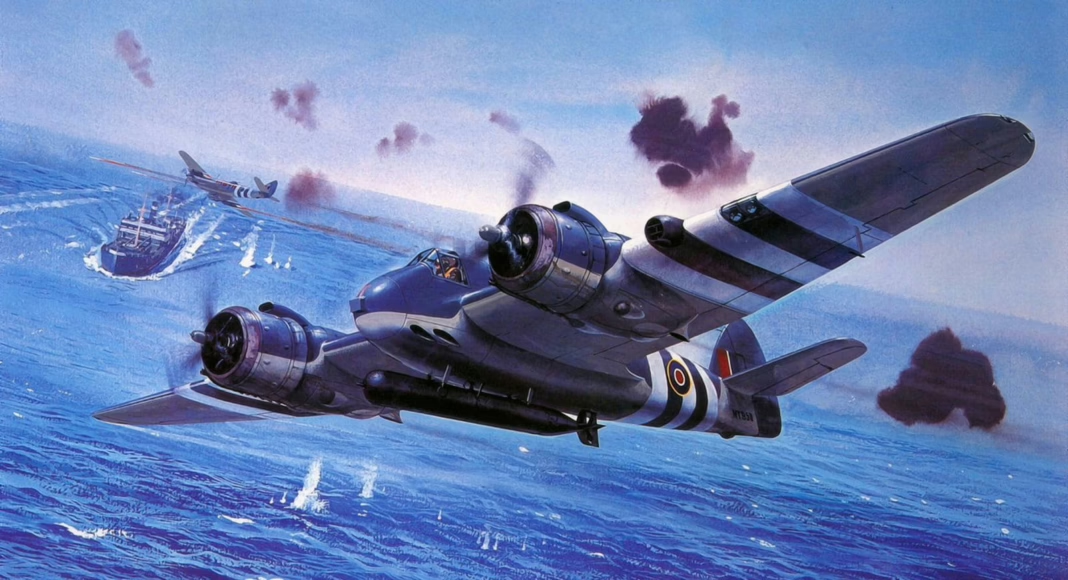Bristol Beaufighter History
The mighty Bristol Beaufighter was the first dedicated night fighter employed by the Royal Air Force (RAF), and it helped pioneer radar-directed ground-controlled intercepts. It also functioned brilliantly as a torpedo-bomber, sinking scores of Axis vessels.
By 1938 the coming crisis in Europe highlighted Britain’s deficiency in modern long-range fighters. That year Leslie Frise of Bristol commenced a company-funded project to design a large aircraft of unprecedented range and firepower. To save time, he utilized the tail and rear fuselage of the Bristol Beaufort then in production. The prototype Bristol Beaufighter first flew in September 1939 as a mid-wing, all-metal monoplane, with retractable undercarriage and hydraulically operated split flaps. By the end of the May 1940 three other prototypes were flying, and the first small batch of Mk IF production aircraft was accepted by the RAF in 1940.
The Bristol Beaufighter was fitted with no less than four 20 mm cannons in the belly and six 0.303-inch machine guns in the wings. Test flights proved that the Beaufighter was fast and manoeuvrable for its size, so the RAF decided to employ them as night fighters. Accordingly, they were fitted with the top-secret A/I radar system. These machines debuted in October 1940 and, guided by ground radar to their targets, destroyed many bombers. Beaufighters were the most potent night fighters in production and service, and by the end of 1940 they were performing also as day fighters in the Western Desert.
In the spring of 1941, No 143 Squadron of Coastal Command became the first unit to operate the Bristol Beaufighter Mk IC, a coastal protection and anti-shipping version otherwise similar to the Mk IF and also powered by 1,590 hp Hercules XI engines. To avoid undue drain on the output of Hercules engines, orders were also placed for the Merlin-engined Mk II, two prototypes of which had been flown in 1940. Four hundred and fifty production Mk IIs were built, with the 1,280 hp Merlin XX as their standard powerplant. Most o them served as night fighters in the UK, but a number were delivered to the Fleet Air Arm.
A slight tendency toward instability, already noticed in the Bristol Beaufighter I, became even more noticeable in the Mk II with its longer Merlin nacelles. It was cure, after some experiment, by giving the tailplane 12 degrees of dihedral on all aircraft of the type. The Mks III, IV and V were experimental variants, the next large-scale model being the Mk VI, produced like the Mk I, as the VIF and VIC for Fighter and Coastal command respectively. A number of Bristol Beaufighter VIF aircraft served with the United States Army Air Force (USAAF) in 1943, and others were fitted with the AI radar nose ‘thimble’ that later characterised the TF Mk X.
Bristol Beaufighter Specifications
| Aircraft Type: |
| fighter |
| Dimensions: |
| wingspan: 57 ft, 10 in |
| length: 41 ft, 8 in |
| height: 15 ft, 1 in |
| Weights: |
| empty: 14,600 lb |
| gross: 21,600 lb |
| Power plant: |
| 2 × 1,670 hp Bristol Hercules XVI radial engines |
| Performance: |
| maximum speed: 333 mph |
| ceiling: 26,500 ft |
| maximum range: 1,480 mi |
| Armament: |
| 6 × 0.303 in/mm calibre machine guns |
| 4 × 20 mm calibre cannons |
| 2,000 lb of bombs or rockets |
| Operational Use: |
| 1940–1957 |





